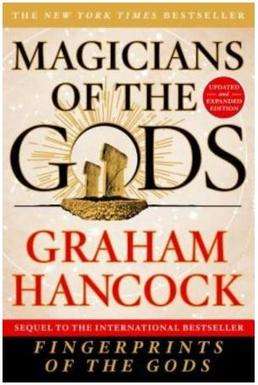Magicians of the Gods
 | |
| Author | Graham Hancock |
|---|---|
| Language | English |
| Published |
|
Publication date | 2015 |
| ISBN | 978-1-250-11840-0 |
Magicians of the Gods: The Forgotten Wisdom of Earth's Lost Civilisation is a 2015 book by British pseudoarchaeology writer Graham Hancock. It is published by Thomas Dunne Books in the United States[1] and Coronet in the United Kingdom.[2] An "updated and expanded" paperback edition was released in 2017.[3]
A sequel to Hancock's Fingerprints of the Gods (1995), the book is based on the premise that there was a highly advanced "lost civilisation" in prehistory that was destroyed in a global catastrophe. In Magicians of the Gods, Hancock seeks an explanation for this catastrophe in the controversial Younger Dryas impact hypothesis, suggesting that around 10,800 BC the earth was struck by the fragments of a large comet, causing widespread destruction, climate change, and sea level rise. He then recounts that the survivors of this catastrophe, the titular "Magicians", dispersed across the world to pass on the knowledge of their lost civilisation. He links this to the construction of various ancient monuments, including Göbekli Tepe, Baalbek, and the Pyramids of Giza, which Hancock claims are much older than mainstream archaeologists say.[4]
Literary reviewers found the book ludicrous but entertaining,[1][5] whilst sceptic and mainstream academic reviewers have criticised Hancock for a litany of factual errors, selective use of evidence and logical fallacies.[6][7] It appeared on the New York Times best seller list in the category "Religion, Spirituality and Faith" in December 2015.[8]
Synopsis
Hancock's thesis is based on the widely criticised[9][10][11] Younger Dryas impact hypothesis, which proposes that the Younger Dryas climate event was caused by one or more large comets striking the earth around 10,800 BC. Hancock argues that this caused widespread destruction, with a short-term return to Ice Age conditions followed by massive flooding that altered the continental landscape. Specifically, he claims that coastal civilisations in and around the Atlantic Ocean, Southeast Asia and the Pacific Ocean were destroyed by rising sea levels. He argues that this was the origin of various flood myths around the world, and that "what we think of as human history is merely the record of human events that have transpired since the last, great planetary catastrophe."
To support his theory, Hancock discusses archaeological sites such as Göbelki Tepe in Turkey, the Roman Heliopolis in Lebanon, and the Egyptian pyramids. He claims that these sites were built much earlier than accepted by orthodox history, with techniques and technology that were not yet supposed to be in existence. He therefore supposes that they were constructed by the hypothetical advanced civilisations destroyed by the Younger Dryas impact event, or else the survivors of the event and their immediate descendants. In the later case, he proposes that their purpose was to pass on the knowledge of these pre-cataclysm civilisations, with their builders being the book's titular "magicians of the gods".
Reception
Literary reviewers have described the book as ludicrous but entertaining. Michael Taube of The Washington Times wrote, "obviously, I don’t believe in Mr. Hancock’s creative fairytale [...] but if a little magic is your cup of tea, this phantasmagorical book will do the trick."[1] Kirkus Reviews concluded that it is "risible and sure to sell."[5] Conversely, sceptic author Jason Colavito considered it "not a good book by either the standards of entertainment or science", describing it as derivative of previous works of catastrophist pseudoarchaeology, and saying that it showed "Hancock at his worst: angry, petulant, and slipshod."[6]
References
- 1 2 3 Taube, Michael (December 30, 2015). "Book Review - Magicians of the Gods". The Washington Times.
- ↑ Cowdrey, Katherine (2017-03-13). "Coronet acquires two books from Graham Hancock". The Bookseller. Retrieved 2017-11-18.
- ↑ "Magicians of the Gods | Graham Hancock". Macmillan Publishers. Retrieved 2017-11-18.
- ↑ "Magicians of the Gods (2015)". Graham Hancock Official Website. Retrieved 2017-11-18.
- 1 2 "MAGICIANS OF THE GODS by Graham Hancock". Kirkus Reviews. 2015-09-03.
- 1 2 "Magicians of the Gods Review". Jason Colavito. Retrieved 2017-11-16.
- ↑ Defant, Marc J. (2017-09-27). "Conjuring Up a Lost Civilization". Skeptic. Retrieved 2017-11-18.
- ↑ "Religion, Spirituality and Faith Books - Best Sellers". The New York Times. 2015-12-13. ISSN 0362-4331. Retrieved 2017-11-18.
- ↑ Kerr, Richard A. (2010). "Mammoth-Killer Impact Flunks Out". Science. 329 (5996): 1140–1141. doi:10.1126/science.329.5996.1140. ISSN 0036-8075. PMID 20813931.
- ↑ Pinter, Nicholas; Scott, Andrew C.; Daulton, Tyrone L.; Podoll, Andrew; Koeberl, Christian; Anderson, R. Scott; Ishman, Scott E. (2011). "The Younger Dryas impact hypothesis: A requiem". Earth-Science Reviews. 106 (3): 247–264. doi:10.1016/j.earscirev.2011.02.005.
- ↑ van Hoesel, Annelies; Hoek, Wim Z.; Pennock, Gillian M.; Drury, Martyn R. (2014). "The Younger Dryas impact hypothesis: a critical review". Quaternary Science Reviews. 83 (Supplement C): 95–114. doi:10.1016/j.quascirev.2013.10.033.
External links
- Magicians of the Gods on the author's website